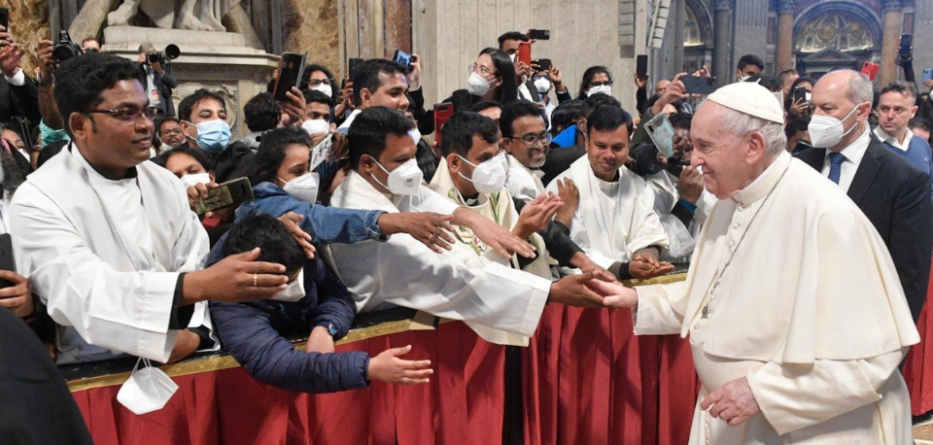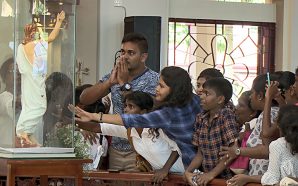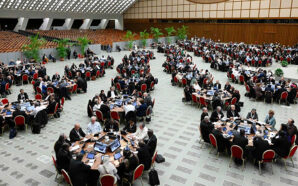One cannot understand the pontificate of the Argentine pope without seeing it as a continuation and development of the guiding vision of the Second Vatican Council
Catholics who believe that the Church would still benefit from putting more effort into the reception of the Second Vatican Council (1962-65) find a great ally in Pope Francis. At the start of his pontificate in March 2013, the reception of Vatican II seemed to be at a standstill. While Church leaders acknowledged that the council was a highly consequential event in recent history, one would only rarely hear them refer to it as being relevant for addressing current pastoral challenges. Many Catholics lamented that the enormous enthusiasm that once accompanied the council’s implementation was a distant memory.
Things have changed in the last ten years. It is safe to say that Francis has inaugurated a new phase in the council’s reception. In contrast to the past few decades, however, this new phase has been marked by a positive disposition toward the “spirit of Vatican II” — not in the sense that the pope or the bishops who are aligned with his vision for the Church use this controversial expression, but that its content animates their pastoral initiatives.
When interpreting texts, it is common to distinguish between the “letter” and the “spirit.” The “letter” refers to the words of the text, and the “spirit” designates the intention of the author. Because of the complex dynamics involved in human verbal communication, this distinction can be useful for understanding texts, including the documents of Vatican II, and for implementing them. Furthermore, it is also common to point out that Vatican II was more than a printing house, and that it cannot be reduced to its documents. To get at this “more”, such concepts as “experience”, “spirit”, or “event” have been used.
Vatican II: something more than just its final documents
Distinguishing between the letter and the spirit, whether with reference to texts or a council, should not be controversial. Even Pope Benedict, who was a staunch critic of the “spirit of Vatican II”, even as the theologian Joseph Ratzinger, supported the idea that the council was more than its final documents. In 1965, reflecting on the third session of the council, he said that the event of the council consisted of a spiritual awakening on the part of the bishops, and that “it was more important in many respects than the texts [the council] passed, for these texts could only voice a part of the new life that had been awakened in this encounter of the Church with its inner self”.
The fact is, however, that the “spirit of Vatican II” did become controversial. The controversy can be traced to the disagreements among the founding members of the journal Concilium in the early 1970s and the subsequent founding of the journal Communio. It gained full force in the 1980s during the pontificate of John Paul II, after Ratzinger, one of the founders of Communio, became the prefect of the Congregation for the Doctrine of the Faith.
While John Paul was positively disposed to Vatican II, he believed that a faulty understanding and implementation of the council were in large part responsible for a fragmentation of Catholicism’s global unity. To rescue the reception of the council from the wrong path on which he believed it was moving, the pope adopted Cardinal Ratzinger’s diagnosis according to which the problems with the council’s implementation were due mainly to the misapplication of an otherwise valid but vague notion of the “spirit of Vatican II.” Ratzinger believed that progressive theologians, such as his earlier colleagues from Concilium, distorted the council by severing the “spirit of the council” from its documents, creating an image of the council as an agent of change that breaks with the previous theological tradition. This view of the council in turn fueled calls for further changes in the church based on the “spirit of the council.”
Ignoring and denouncing appeals to the “spirit of Vatican II”
Both the pope and Cardinal Ratzinger believed, however, that further changes in the Church were unwise and that justifying them based on the “spirit of Vatican II” was without merit, for they lacked support in the council’s documents. They believed that the concept of the “spirit of Vatican II” stood in the way of an authentic reception of the council. To return the Church to normalcy, they promoted a hermeneutic of the council that emphasized continuity and downplayed its discontinuity with the historical tradition.
While not eliminating the “spirit of Vatican II” from discussions of the council’s reception, its role was greatly restricted. Appeals to the “spirit of the council” to bring out change in the church were ignored or denounced. Over time, the “spirit of Vatican II” became a villain whose role in the narrative about the council needed to be placed under tight control. Recently, some from traditionalist circles have argued that the Church would be served best if the “spirit of Vatican II” were slain.
While one may agree with some criticisms of how the concept of the “spirit of Vatican II” was used in the 1970s, restricting or dismissing it distorts the council itself. As I said earlier, distinguishing between the “letter” and the “spirit” of texts, and affirming that Vatican II was more than a printing house, should not be controversial. Most experts agree that the council was both “a corpus of documents and an event, and that it should be known and understood both in its letter and in its spirit”.
The council’s guiding vision and orientation
What is meant by the expression the “spirit of Vatican II”? When one studies the deliberations among council participants and examines the developments that various documents went through from their initial drafts to their final form, it is possible to discern a general direction and a guiding vision. The “spirit of Vatican II” refers to that guiding vision or orientation of the council. At its core is the reform and renewal of the church. With the help of the German theologian Hermann Pottmeyer, I define the “spirit of Vatican II” as “the intellectual and spiritual impulse toward renewal that animated the work of the council itself and that emanates from it.” This is the spirit that the texts of Vatican II embodied and articulated.
In addition to renewal and reform, when I think of the “spirit of Vatican II,” courage comes to mind. Courage (or fortitude) is one of the gifts of the Holy Spirit. Given the ecclesial climate of the preceding decades, it took courage to reject some preparatory schemas for the council and demand that more than neoscholastic theology be incorporated in them. I see this courage in the ressourcement and aggiornamento that the bishops promoted and especially in the commitment to dialogue with other Christians, non-Christians, and with all people in which the council called Catholics to engage. It took courage not only to teach that tradition develops but to develop it at the time when the episcopal motto of the head of the Holy Office was semper idem (always the same).
Reform, renewal, and courage are arguably key markers of Pope Francis’ pontificate. The emphasis on reform and renewal permeates his speeches, but more importantly, Francis embodies reform and renewal in the initiatives he promotes and the decisions he makes. Chief among them is synodality. In the view of many, developing synodality at every level of the Church has been the most important reform of his pontificate. He has been relentless in trying to transform the Church marked by centralization and dogmatism with a culture of dialogue and encounter. Synodality designates an attitude of openness toward the adoption of structures promoting co-responsibility in the Church. The practice of synodality consists of listening to everyone in the Church and of discerning how best to realize the demands of the gospel.
A re-reception and further development of Vatican II
Synodality can be seen as a rejection of a culture in which the clergy know what is best, and the role of the laity is simply to allow themselves to be led. More than a means to bring about a change of Church teachings or structures, Francis sees synodality as a process that will bring about a Church in which a broader spectrum of the faithful have a voice and share in responsibility for its life.
Synodality can be seen as both a re-reception and a further development of the council’s ecclesiology, especially regarding its understanding of the Church as the People of God, and its teaching about sensus fidelium and collegiality, all of which are expressions of the council’s impulse toward reform and renewal.
The revival of the “spirit of Vatican II” can be seen also in the way Pope Francis exercises teaching authority. The interrelation of the “doctrinal” and the “pastoral” was a distinctive feature of Vatican II. One can argue that more than any other pope since the council, Francis has realized the kind of pastoral magisterium that Pope John XXIII called for in his opening speech at the start of Vatican II. As Richard Gaillardetz has pointed out, Francis teaches by “recontextualizing doctrine in service of the Church’s pastoral mission”. In this way, he has advanced the notion of “the pastorality of doctrine”.
Francis’ courageous defense of Vatican II
A final example of how Pope Francis has revived the “spirit of Vatican II” concerns the council’s liturgical reform. This was one of its most important achievements, and it went hand-in-hand with its renewal of ecclesiology. With his motu proprio Traditionis custodes, Francis firmly defends the council’s reform of the liturgy and makes clear that it should be seen as an expression of the living tradition. Other examples of how Francis has advanced the council’s liturgical reform are his return of authority over liturgical translations to the bishops, his decision to open instituted ministries of lector and acolyte to both men and women, establishing a newly instituted ministry of catechist, which is also open to men and women, and restricting private Masses at St. Peter’s Basilica in favor of celebrations with people.
The examples of synodality, pastoral exercise of the magisterium, and defense of the liturgical reform are also an indication of courage with which Francis is leading the Church. Ecclesial renewal and reform can be bothersome, especially to those who (mistakenly) associate change in the Church with a lack of fidelity to tradition. They have criticized the pope severely, but he has responded with courage.
The last ten years have shown that much of the opposition to him is rooted in a misrepresentation and, at times, a seeming rejection of Vatican II. It has become more and more evident that Francis has overturned one of the principal narratives regarding the reception of Vatican II, namely, that his two predecessors “delivered the final, definitive interpretations on all the key issues that the council addressed.” Under Francis, the reception of the council continues.
One cannot comprehend what the current pope has done apart from the Second Vatican Council. For many, he has reconnected the Church with the energy of Vatican II and refreshed that experience of the Church that people had following the reforms of the council. He has revived its spirit and rehabilitated it.
Martin Madar is professor of systematic theology and ecclesiology at the Jesuit-run Xavier University in Cincinnati, Ohio (USA). He is the author of The Church of God and Its Human Face (Pickwick 2019).
The views expressed in this article are those of the author and do not necessarily reflect the official editorial position of La Croix International
Reproduced with permission from La Croix International.








